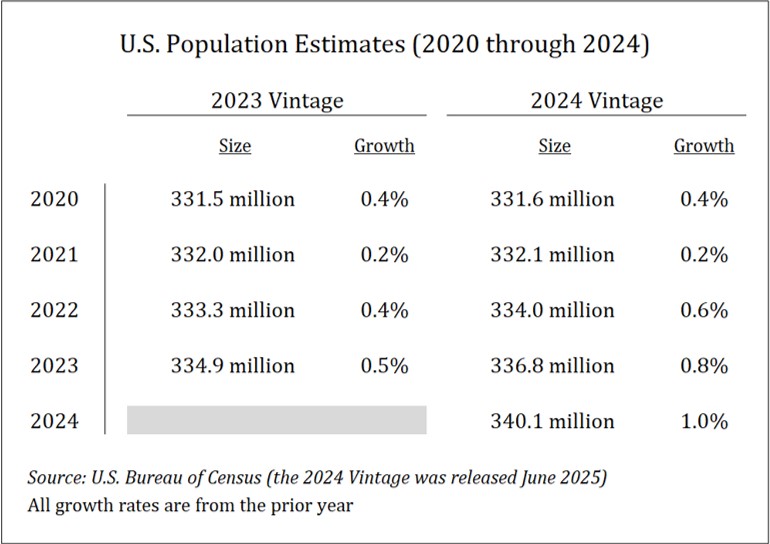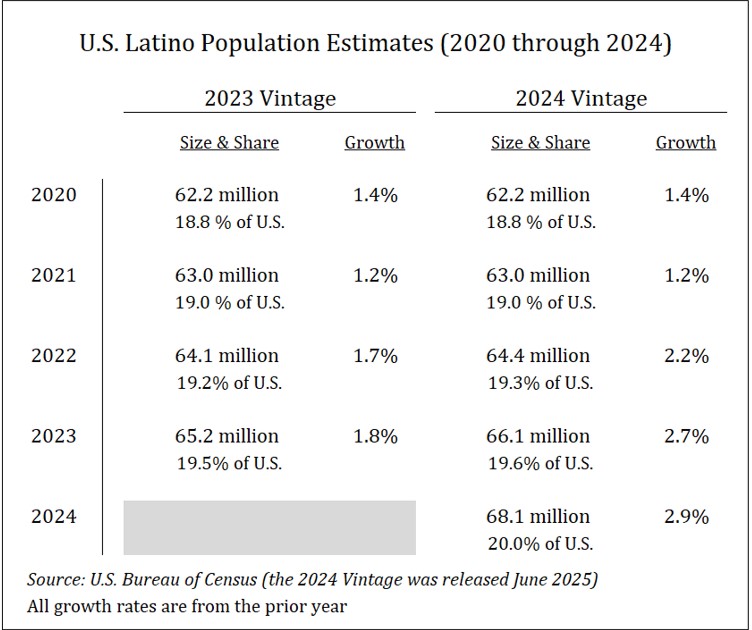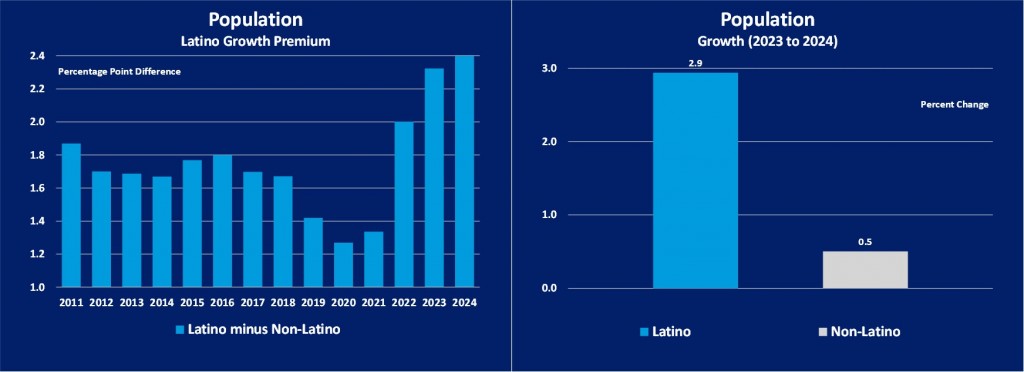CERF Blog
The Census Bureau’s recent June 2025 official U.S. population estimates indicate strength for the economy. This strength will accrue via various channels described in this essay. America is larger than previously understood. The estimated number of Americans as of July 1, 2023 rose by 1.9 million persons, and the previously estimated 2023 U.S. population growth rate of 0.5 percent is now estimated to be a more robust 0.8 percent. The U.S. population change since 2010 is now understood to be about 30 million persons, as compared with about 25 million people based on previous estimates. See Table 1 for these estimates.
Table 1: Official U.S. Population Estimates
The 2023 revised data provide greater optimism both via size and growth measures. The U.S. was actually 1.9 million-persons larger than previously measured for July 1 2023, and, the revised growth rate is nearly twice as fast as the previous growth estimate.
These population estimates also show newly-understood demographic strength by ethnicity, with both Latino and Non-Latino population growth rates significantly faster than previously estimated. The 2023 Non-Latino population growth rate is now estimated to be 0.4 percent, compared to a previously estimated 0.2 percent. The 2023 Latino population growth rate is now estimated at 2.7 percent, versus a previously estimated 1.8 percent.
Table 2: Official U.S. Latino Population Estimates
This hard-working, household and family-building cohort, the U.S. Latino cohort, is growing in every way, in absolute numbers, and in shares of the U.S. demography and economy (Hamilton et al, 2025). With the new data revealing an updated estimate of the size of the U.S. Latino population, we can see that Latinos are creating an even greater demographic and economic punch than previously understood.
The Census Bureau’s June 2025 data release also provides new, never before released population estimates for 2024. The United States population as of July 1, 2024 is estimated to be over 340 million persons, which is 3.3 million persons greater than 2023 (using current estimates) and perhaps more importantly, 5.2 million persons greater than the earlier estimates of 2023. This provides a different picture of America than previously understood.
The release also provides never before seen population estimates by ethnicity for 2024, 68.1 million Latinos and 272 million Non-Latinos. Our understanding of the size of the 2024 Latino cohort is that it is 2.9 million persons larger than the previous estimates of 2023, and the new Non-Latino cohort size is 2.3 million persons greater than previous estimate of 2023.
The Latino cohort is now, for the first time in history, one out of every five persons in the United States. Their 2024 population growth rate was three times as fast as that of the overall country, and 5.8 times as fast as the Non-Latino cohort. Their population growth premium, that is, the difference of their one-year growth rate over that of Non-Latinos, was 2.4 percent in 2024, a historical high, see Figures 1 and 2.
Figure 1: Latino and Non-Latino Population Growth
The rapidity of Latino population growth provides another channel by which the American economy will exhibit strength going forward. The Latino cohort, as described by Hamilton et al 2025, is younger, more likely to work, is accumulating human capital at a higher rate, has higher income growth, and is forming households at a more rapid rate than the Non-Latino cohort, all of which will provide strength and vitality to the American economy in future years.
References
Hamilton, D., M. Fienup, D. Hayes-Bautista, and P. Hsu. 2025. “2025 U.S. Latino GDP Report: Hard-Working, Self-Sufficient, Optimistic.” Community Partners, April 2025.




